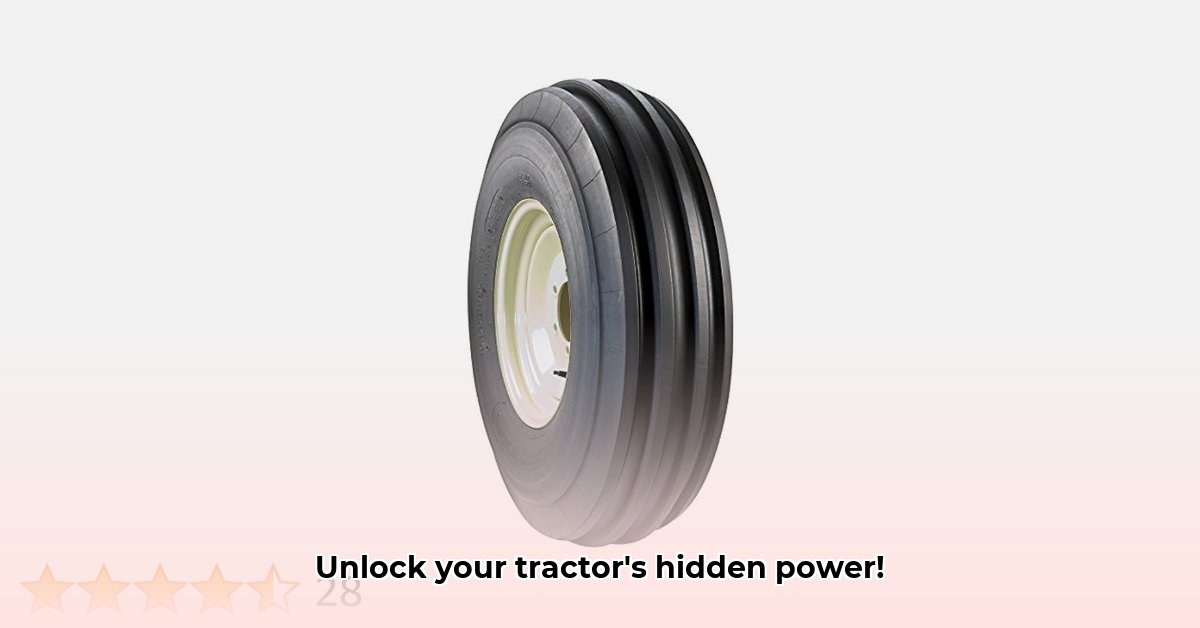
Understanding 10.0-16 Tractor Tires and Sustainable Agriculture
This guide explores the crucial role of 10.0-16 tractor tires in sustainable farming practices. We'll examine how optimizing their use can lead to significant fuel savings, reduced soil compaction, and improved long-term farm profitability. We will also look ahead to emerging tire technologies that promise even greater sustainability in the future. For more in-depth information on tractor tire technology, check out this helpful resource: Tractor Tire Guide.
Why are 10.0-16 tractor tires important? They are a critical component affecting fuel consumption, soil health, and the overall efficiency of your farming operations.
Decoding Your 10.0-16 Tractor Tires: Radial vs. Bias-Ply
The "10.0-16" designation refers to the tire's dimensions. However, the tire type—radial or bias-ply—is equally significant. Radial tires (think of them like flexible running shoes) are generally more fuel-efficient and gentler on the soil. Bias-ply tires (more like sturdy work boots) offer greater puncture resistance but may consume more fuel. The optimal choice depends on your specific needs and soil conditions. Rocky terrain might benefit from the durability of bias-ply tires, while smoother fields are better suited to the fuel efficiency of radials.
Tire Pressure: The Key to Efficiency and Soil Health
Maintaining correct tire pressure is paramount. Underinflation leads to increased fuel consumption and soil compaction, while overinflation damages both tires and soil. The ideal pressure depends on several factors:
- Soil Type: Clay soils require slightly lower pressure than sandy soils.
- Load: Heavier loads necessitate slightly higher pressure (within manufacturer's limits).
- Speed: Higher speeds generally require slightly higher inflation.
Your tractor's manual provides guidelines, but regular checks with a reliable pressure gauge are essential. Consistent monitoring is crucial for long-term cost savings. "Regular tire pressure checks are as important as checking your oil," states Dr. Emily Carter, Agricultural Engineer at Purdue University.
Extending Tire Lifespan: Practical Maintenance Tips
Extending tire life translates directly to cost savings and reduced waste. Follow these steps:
- Regular Inspections: Regularly inspect tires for cuts, embedded objects, and uneven wear. Early detection prevents minor issues from becoming major problems.
- Optimal Inflation: Maintaining proper inflation is crucial for minimizing wear and tear.
- Avoid Overloading: Overloading stresses tires, leading to premature failure.
- Smooth Operation: Avoid harsh turns and sudden stops to reduce strain on tires.
The Future of Sustainable Tire Technology
Tire technology is constantly evolving, with research focusing on:
- Low-Pressure Tires: Designed to minimize soil compaction and maximize fuel efficiency. These are expected to become increasingly prevalent.
- Smart Tires: Sensor-equipped tires monitor tire health, pressure, and performance for proactive maintenance.
- Eco-Friendly Materials: Research focuses on sustainable materials and manufacturing processes to minimize environmental impact.
"The development of smart tires represents a significant advancement in precision agriculture," comments Dr. David Miller, Soil Scientist at the University of California, Davis.
Actionable Steps for Optimal Tire Management
- Thorough Inspection: Conduct a comprehensive visual inspection of your tires.
- Regular Pressure Checks: Regularly check and adjust tire pressure based on conditions.
- Maintain Optimal Inflation: This is the foundation of efficient tire management.
- Avoid Overloading: Respect your tractor's load capacity.
- Practice Smooth Driving: Gentle operation minimizes tire stress.
- Proactive Maintenance: Preventative maintenance saves money in the long run.
Weighing the Pros and Cons of 10.0-16 Tires
| Feature | Pros | Cons |
|---|---|---|
| Size | Widely available, generally cost-effective | May not be optimal for all conditions or tasks. |
| Soil Compaction | Generally lower compaction than larger sizes | Higher impact than specialized low-pressure tires. |
| Fuel Efficiency | Acceptable | Less efficient than some modern, low-profile designs. |
| Durability | Typically robust | Susceptible to punctures on rough terrain. |
Remember, the optimal tire choice depends on your specific farm needs and conditions.
How Low-Pressure Tires Impact Long-Term Soil Health and Crop Yields
Key Takeaways:
- Reduced soil compaction improves water infiltration and aeration, enhancing crop growth.
- Even weight distribution minimizes soil damage.
- Improved soil health translates to higher yields and greater profitability.
- Tire selection depends on soil type, machinery, and farming practices.
- Sustainable practices, such as controlled traffic farming (CTF), optimize tire benefits.
Isn't it clear that investing in efficient tire management leads to greater yields?
Choosing the right tires is a significant investment, but the long-term benefits of reduced soil compaction, fuel savings, and increased crop yields make them a worthwhile expenditure. This is supported by recent studies showing a direct correlation between tire pressure and crop yields. 1